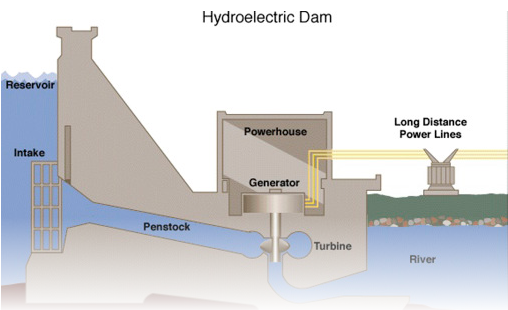Exploring the Significance and Challenges of Hydropower Energy (GS Paper 3, Science & Tech)

In the Headlines
- Recent droughts in Colombia and Ecuador have brought attention to the vulnerabilities of hydropower as a source of energy.
The Importance of Hydropower Energy
- Hydropower utilizes the kinetic energy of flowing water to generate electricity, offering numerous benefits:
- Renewable Source: Relies on the continuous water cycle driven by the sun, ensuring sustainability.
- Clean Energy: Produces electricity without air pollution or toxic byproducts, contributing to environmental preservation.
- Energy Independence: Enables domestic energy production, reducing reliance on imported fuels and enhancing security.
- Flexibility: Allows for rapid adjustment of output to meet fluctuating demand, providing reliable backup power.
- Scalability: Projects can range from small-scale systems to large-scale infrastructure, catering to diverse needs.
- Multipurpose Use: Often involves the construction of dams and reservoirs, offering benefits beyond electricity generation.
- Combatting Climate Change: Responds to weather changes by managing water resources effectively.
- Cost-Effectiveness: Offers low-cost electricity with long-term viability, offsetting initial construction expenses.
- Synergy with Other Renewables: Complements wind and solar energy, ensuring a stable energy supply.
- Eco-Friendly Solution: Plays a crucial role in creating clean and secure electricity systems, aligning with global sustainability goals.
- Expansion Potential: Expected to grow substantially due to its cost-effectiveness and scalability.
Challenges Facing Hydropower Energy
Despite its advantages, hydropower encounters several challenges:
- Global Decline: Experienced a significant drop in output in recent years, impacting its reliability.
- Climate Change Vulnerability: Altered weather patterns and extreme events threaten infrastructure and water availability.
- Drought Impact: Reduced reservoir levels during droughts lead to power shortages and rationing.
- Overreliance: Heavy dependence on hydropower leaves countries vulnerable to climate impacts and supply disruptions.
- Limited Alternatives: Insufficient capacity for alternative energy sources poses challenges during crises.
- Environmental Impacts: Construction of dams disrupts ecosystems, alters water quality, and affects wildlife.
- Water Allocation Conflicts: Competing demands for water use create tensions over rights and distribution.
- Social Disruptions: Large-scale projects displace communities, leading to loss of livelihoods and cultural heritage.
- Geological Hazards: Infrastructure is susceptible to natural disasters, posing safety risks and operational challenges.
- High Costs: Construction of large-scale plants requires significant investment and resources.
Future Directions
Efforts are underway to address these challenges and promote sustainable energy solutions:
- Embracing Diverse Technologies: Ghana and Kenya are diversifying their energy portfolios beyond hydropower.
- Exploring Innovations: Floating solar panels on reservoirs and medium-scale plants offer promising alternatives.
- Advocating for Sustainability: Organizations like the International Hydropower Association advocate for integrated approaches to achieve energy goals.
Conclusion
- In navigating the complexities of hydropower energy, prioritizing environmental stewardship, social responsibility, and technological innovation will be key to ensuring a resilient and sustainable energy future.


